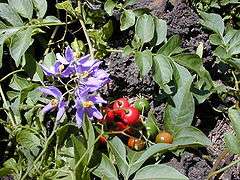Solanum seaforthianum
| Solanum seaforthianum | |
|---|---|
 | |
| Scientific classification | |
| Kingdom: | Plantae |
| (unranked): | Angiosperms |
| (unranked): | Eudicots |
| (unranked): | Asterids |
| Order: | Solanales |
| Family: | Solanaceae |
| Genus: | Solanum |
| Species: | S. seaforthianum |
| Binomial name | |
| Solanum seaforthianum L. | |
Solanum seaforthianum, the Brazilian nightshade,[1] is a flowering evergreen vine of the Solanaceae family native to tropical South America. As a member of the Solanum genus, it is related to such plants as the tomato and potato. It is characterized by clusters of four to seven leaves and can climb to a height of 20 ft (6 m) given enough room. It blooms in the mid to late summer with clusters of star-shaped purple inflorescence followed by scarlet marble-sized berries. The plant is highly heat resistant, but cannot tolerate frost conditions. The plant contains modest amounts of various tropane alkaloids such as atropine, scopolamine and hyoscyamine and should be considered mildly toxic and inedible.[2]
The species has become widely naturalised outside its native range and is an invasive species in Australia, Africa, Indochina, the Pacific Islands and India, choking native vegetation and poisoning livestock.[3]

References
| Wikimedia Commons has media related to Solanum seaforthianum. |
- ↑ "Solanum seaforthianum". Natural Resources Conservation Service PLANTS Database. USDA. Retrieved 17 November 2015.
- ↑ Janaki-Ammal, E.K.; Viswanathan, T.V. (1975). "A new garden plant for India: tetraploid Solanum seaforthianum". Indian Horticulture. Sept 1975: 25.
- ↑ "Factsheet - Solanum seaforthianum (Brazilian Nightshade)". lucidcentral.org.